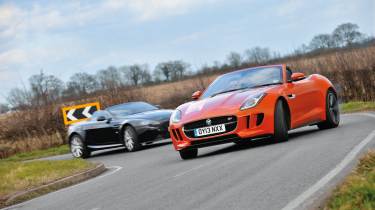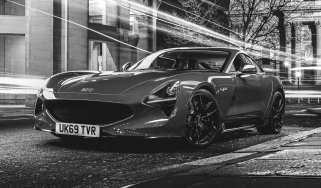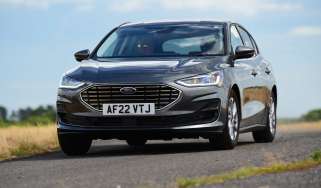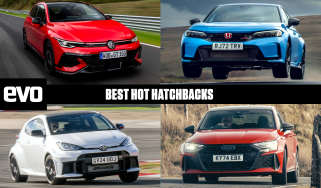Jaguar F-type V8 S vs Aston Martin V8 Vantage Roadster
We find out how Jaguar's top-spec V8 S Roadster compare to the most British of rivals, the Aston Martin V8 Vantage Roadster
The Aston is the first to arrive and, inevitably, jaws drop. In the simultaneously piercing sun and piercing cold so typical of former WW2 airfields in central England during spring, the Aston’s curves glint and gleam. The shape is as acutely beautiful and essentially right as it was back in 2007 when we saw the V8 Vantage Roadster for the first time. Like all great roadsters, its aesthetic works because the range was designed with an open-top in mind: short, taut and with bodywork like silk stretched over muscle. Yep, the Aston Martin V8 Vantage exudes a superstar vibe.
But modern Astons have never had a problem with styling. The issue is older mechanicals – refined, evolved and improved, maybe, but older nonetheless. The Roadster is six years old, and the coupe made its debut in concept form in 2003.
Today the Aston has a new problem. Another V8 arrives. Another short, taut body disguising an aluminium chassis, and another growly, hollow soundtrack. Not only that, it’s also a car designed with an open top in mind. But unlike the Aston, it is being launched as an open-top first. It’s the new Jaguar F-type V8 S, and it pulls up alongside the Vantage spitting all manner of acoustic fireworks from its exhaust – like a flyweight boxer throwing insults at the established champion.
More reviews
At £79,985, the V8 S is the most expensive F-type. List for the Aston Martin V8 Vantage Roadster (non-S) is £98,995 – £19k more. However, sub-1500-mile V8 Roadsters frequently crop up in Aston’s pre-owned network for around £85,000, making this head-to-head even more intriguing. It’s the kind of battle that Ford shirked when the brands were siblings in the Premier Automotive Group portfolio.
The Jaguar is faster and more powerful. Its 5-litre supercharged V8 – an engine now in its third generation – develops 488bhp at 6500rpm, against 420bhp at 7300rpm from the Aston’s 4.7-litre naturally-aspirated V8. The Aston is also 45kg heavier (1710kg v 1665kg) according to the spec sheets, making the all-important power-to-weight battle an emphatic victory for Jaguar – 298bhp/ton against 250 for the Aston. Although, interestingly, we weighed the F-type V8 S with two-thirds of a tank of fuel but without a driver and saw 1805kg, of which 20kg was the space-saver wheel, tyre and tools (a £255 option we’d ignore – save the weight and carry a can of tyre weld). Time pressures meant we couldn’t weigh the Vantage, but we don’t doubt that on our scales with a similar amount of fuel, the Aston and Jaguar would show very similar kerb weights.
Bedford Autodrome is open, so we’ll get some initial impressions on the circuit before heading on to the road. The Aston’s swan-wing door swings out and up, and the roof stows quickly, leaving two neat leather-covered humps. The engine fires with a purposeful growl. Snick it into first (we have a manual – our preferred option) and find that the clutch and gearshift actions feel slicker and more direct than ever – one of the many benefits of evolution that will make themselves felt during this test.
Having run a manual V8 Roadster on Fast Fleet, the car feels like an old friend. Muscle memory tells me that you need to turn in hard and fast on track, ideally with a touch of trail braking to break through an initial understeer phase, particularly in the faster corners. If you don’t, the V8’s comparative lack of torque won’t allow you to neutralise mid-corner push with a stab of throttle, leaving you to deal with mild understeer all the way through to the corner exit. It’s a trait that forces a disciplined method of driving, and when you master it there’s real satisfaction in the way you can hustle this car – particularly in the knowledge that when you exceed the limit, the Aston is benign and easy to gather.
Into the Jaguar, and what a difference! At the first corner, the F-type oversteers on the way in, oversteers on the way out and oversteers in the bit in between. The tyres are cold, but it’s a shock after the Aston, a car that only surrenders grip and poise after serious provocation.
The Jaguar needs no such provocation – the steering responds quickly, the rear axle even quicker, and the supercharged engine revs (and sounds) like a NASCAR-engined bandsaw. After driving two or three fast but controlled laps, with some F1-style weaving to generate some heat, the F-type soon gets into its stride. The intensity remains – with the stability systems switched off, traction is broken at will – but real balance and precision emerges from the controls.
This is good news. Initial impressions suggest the F-type V8 S is challenging, fast, enormously fun and has great control feedback. I chuck the keys to Tiff Needell, who has been driving the V6 S for an evoTV video, and ten minutes later he hands them back wide-eyed, spluttering and swearing. I think he enjoyed himself.Familiarisation over, we head onto the road, wondering if the V8 S’s hyperactivity will tie it up in knots – and if the Aston’s civility will claw it back some points lost on track. Dickie Meaden is up front in the Jaguar and when the road opens out, he’s gone – leaving nothing but a mighty bellow from the V8 F-type’s quad ‘Active’ exhausts hanging in the air. Every upshift is accompanied by a giant thunderclap, every downshift by a hollow crackle and a round of artillery fire. If you didn’t know better, you’d think this car had just driven straight through a time-tunnel back from Le Mans in the ’60s.
Keeping up with the Jaguar demands real commitment from the Aston driver. Ours is a standard Vantage, lacking the firmer springs, firmer dampers and quicker rack of the ‘S’ version. But its softer responses and horsepower disadvantage actually give it a traction advantage on the road, delivering a feeling of security on corner exits that the Jag can’t match. Put simply, if you can stay with the Jaguar on the way into the corner, you’ll be crawling all over it on exit until the F-type can deploy all 488bhp – at which point it disappears.
The Aston’s steering is accurate and the relationship between the throttle pedal and steering more synchronised than in the F-type. By this I mean that when you apply the throttle, you simultaneously and intuitively unwind the appropriate amount of lock. Oversteer rarely enters the dynamic envelope unless it is wet and/or you do something really silly.
At road speeds, the Aston’s front and back axle combine to deliver a beautifully neutral stance – so much so that you often try to agitate the chassis with exaggerated steering or throttle inputs. The Aston responds well to this on track, but on the road you’re better driving to the car’s strengths – grip, poise and fluidity – rather than overdriving it to make it behave like something it’s not.
The Jaguar couldn’t be more different (see a trend emerging here?). Its extra 68bhp and more aggressive chassis set-up equates to a busier, more frantic experience for the driver. The damping is abrupt, perhaps too abrupt for England’s recently frost-damaged tarmac, which means the 20in wheels often float over the surface like a speedboat skimming across the waves – traction loading and unloading as the dampers try to keep up. Combine this with an (understandably) overprotective stability control system and your progress over fast ground becomes a jumpy, staccato affair.
It sounds counter-intuitive, but the solution is to switch to Dynamic mode. Throttle response is sharpened, steering weight increased, gearshifts quicken, the adaptive dampers firm up and, most importantly, the stability control system loosens its grip on the Pirelli P Zero rear tyres. Here, the extra degree of overspin combined with the direct steering allows for much more engaging and less interrupted progress. You’re initially shocked at just how quickly the rear will step out, or how quickly the revs will flare over a crest, but after applying more discipline to the throttle pedal, and resisting the urge to overcorrect the steering, the V8 S becomes a real joy to push hard – tail-led rather than tail-happy, and superb fun.
A word of warning though – you need to be absolutely on top of your game, and perhaps a little unhinged, to disable the stability systems fully on the road; there’s a spikiness to the F-type V8 S that we’ve not experienced in a Jag before – not even in the XKR-S. The V8’s active diff (the V6 S has a mechanical LSD) does a decent job of managing the torque across the axle, but there’s a nagging feeling that a conventional LSD would telegraph a little more information to the driver.
The F-type’s steering deserves special praise. The rack is direct and fast (the fastest ever fitted to a Jag) and there’s real information filtering up from the road. Plus it feels like Jaguar has resisted the urge to overdamp the steering. ‘It’s consistent in its behaviour,’ says Meaden, ‘and thanks to its sense of connection feels transparent.’
Time to stop, take a deep breath, and let photographer Dean Smith complain once again that the light isn’t bright/dark/red/orange/pink/blue enough. We park up and Dickie and I swap notes. We soon notice that every passing car jinks as the driver spots the F-type. Its optional Firesand Metallic orange paint undoubtedly steals attention from the black Aston, but so does the detail treatment – those grape-on-scalpel rear lights, the flat, edgy rear deck and the carbon on the optional ‘Blade’ wheels. The F-type is a confidently resolved, modern roadster design – so modern in fact that few believe it’s actually a Jaguar upon first glance. No wonder the car is littered with ‘Jaguar’ scripts…
Inside, the style continues. The joystick gearlever with its forward for down, back for up (i.e. correct) shift directions is a welcome sight (the JLR rotary selector would’ve jarred horribly). The bronze anodised-effect paddles and Dynamic mode toggle enhance the fighter-jet vibe. Some will find the effect a little contrived, especially after the classically tailored Aston, but I like the cabin’s sense of fun. Less impressive is the large central air vent binnacle that rises and falls rather awkwardly, depending on cabin temperature and air direction, and the seat position, which I’d personally like a couple of inches lower.
We head back onto the road, enjoying the manual gearbox in the Aston and conversely wondering if the F-type is a better car for having an eight-speed automatic. There’s little doubt that the Jaguar’s ZF ’box is a peach – the rev-matching on downshifts is supreme, and the rapid upshifts are accompanied by a mighty fwlap! as the ignition is momentarily extinguished. You rarely drop into first gear, and from second upwards there’s a direct mechanical link between the engine and the rear axle – a locking clutch decoupling the torque converter. Ultimately it’s not as fast as a twin-clutch unit, but the sensation of rapid-shifting and the manual control via the light-touch paddles are better than expected.
However, out on English roads you tend to overshuffle the gears somewhat unnecessarily. Rather than extend the revs through to their maximum, you find yourself surfing the fattest part of the torque curve with frequent shifts. Ignore the temptation to overshuffle and hold on to a ratio instead, and you discover a satisfying, VTEC-like punch at around 5500rpm accompanied by a faint scream from the supercharger. The V8 S is short geared. Max in 1st is 43mph, 2nd is 64mph, 3rd 95mph, 4th 121mph, 5th 157mph and 6th, 7th and 8th 186mph.
As for the Aston, it’s a wee bit simpler than that. You orchestrate the performance in a much finer, more intuitive and more interactive manner via the gearlever, clutch and six ratios. I can practically see the Luddites forming an orderly queue behind us…Two days later, I watch the F-type V8 S drive away from the evo office. The experience has undoubtedly been worth the wait – although I suspect Jaguar’s neighbours at Gaydon would have preferred an indefinite delay. The Vantage, like all Astons we’ve experienced lately, remains a compelling proposition despite its advanced years. It feels beautifully honed; polished and evolved with a unique personality and real grace and integrity – but it feels like a car that revealed everything about itself a couple of years ago and has nothing left to show us.
The Jaguar disrespectfully exposes the Aston’s age with sharper dynamics, more focused appeal and a chassis that allows the driver to be more expressive. It’s not perfect by any means, and many will find the V8 S too intense, but the top-of-the-range F-type wins this battle. It is a genuinely thrilling and engaging sports car that will give its rivals a serious headache for several years to come.



